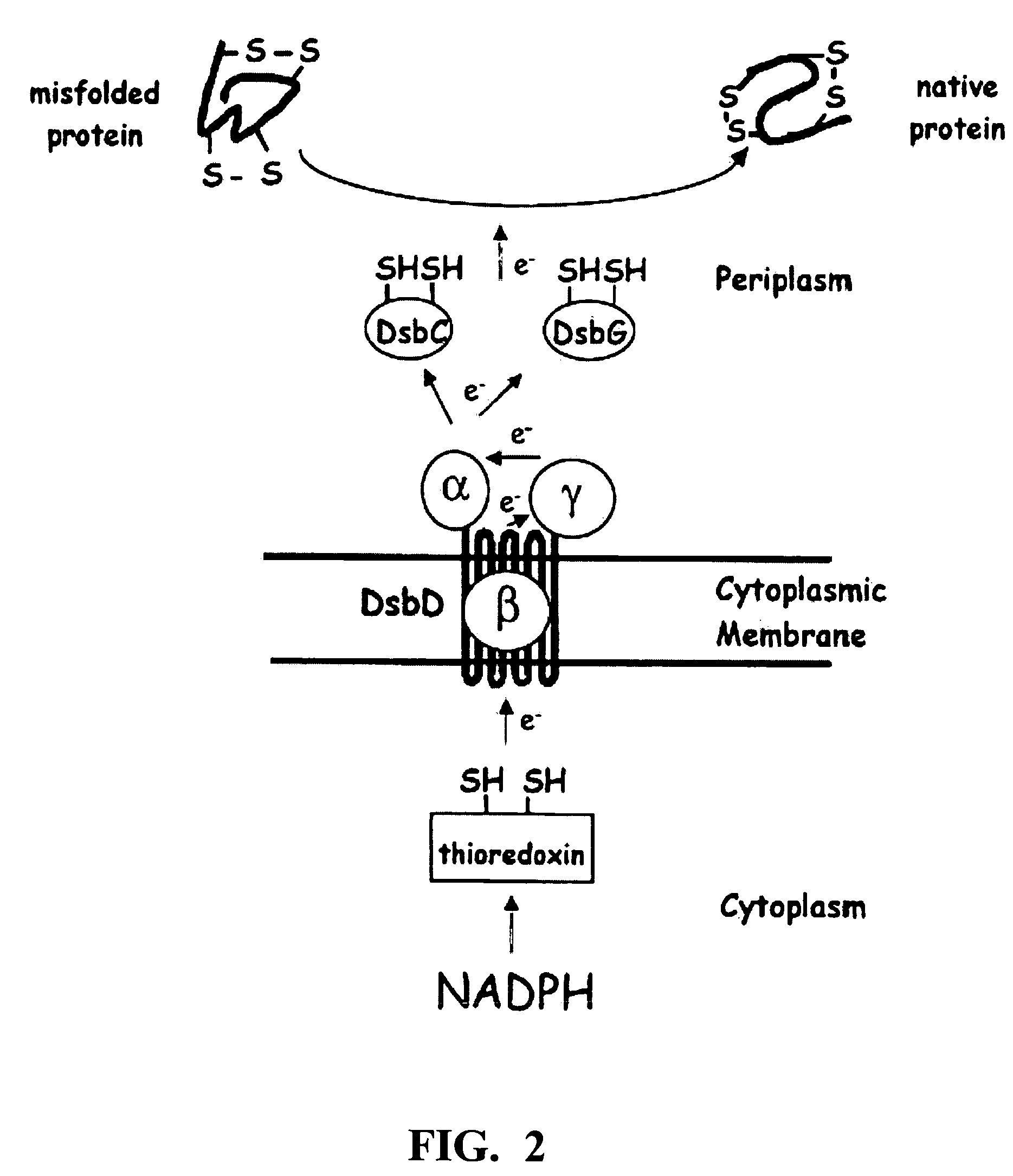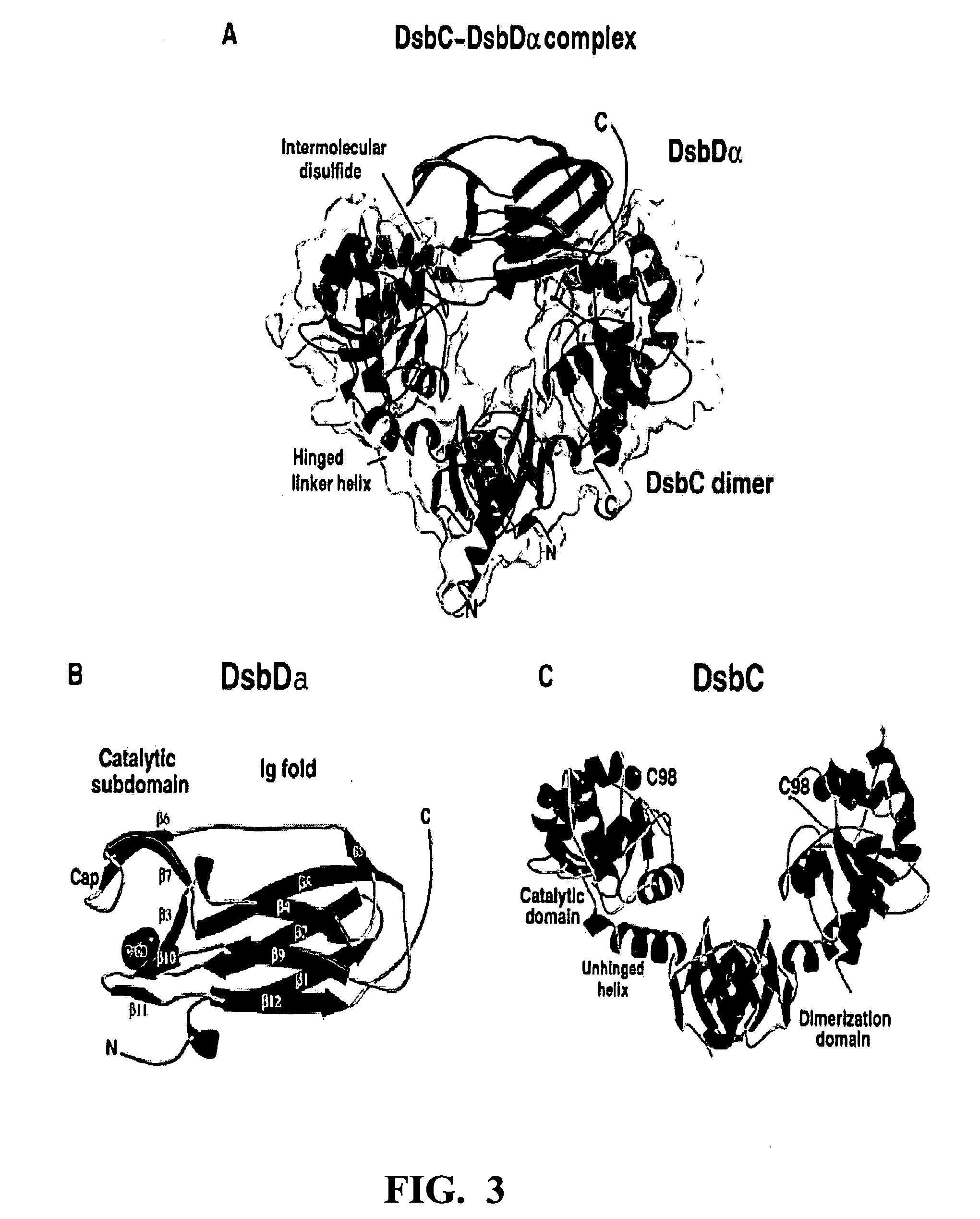Method of expressing proteins with disulfide bridges
a technology of disulfide bridges and proteins, applied in the field of expressing proteins in microbial hosts, can solve the problems of high expression level, failure of eukaryotic and prokaryotic systems to express snake venom disintegrins such as cn as functional native conformers, etc., and achieve the effect of facilitating the proper folding of the nascent recombinant cn disintegrin domain and increasing the affinity of the expressed recombinan
- Summary
- Abstract
- Description
- Claims
- Application Information
AI Technical Summary
Benefits of technology
Problems solved by technology
Method used
Image
Examples
example 1
Expression of Contortrostatin in Origami B Strain of E. coli
[0132] The Origami strain of bacteria (Novagen) that is based on FA113 double mutant was employed for recombinant CN production in bacteria.
[0133] The pET32a vector map shown in FIG. 6 (Novagen, Inc.) has been used for expressing peptide sequences fused downstream of a 109 amino acid thioredoxin wild type protein sequence (LaVallie, DiBlasio et al. 1993). Cloning sites are available for producing fusion proteins also containing cleavable His-tag sequence and S-tag sequence for detection and purification. As disclosed herein, disintegrins including recombinant CN sequences can be expressed as a fusion with thioredoxin to obtain an accelerated disulfide bond formation and an enhanced solubility of eukaryotic protein.
[0134] The sequence HKGPAT, which represents the C-terminal amino acid sequence of the monomeric disintegrin, echistatin, was included at the C-terminal end of the CN disintegrin domain sequence. This construct...
example 2
Biological Activity of Recombinant Contortrostatin Constructs
[0142] A. In Vitro Functional Assays
[0143] The recombinant CN products were evaluated for biological activity by a platelet aggregation inhibition assay. According to this assay, CN binding to GPIIb / IIIa (integrin αIIbβ3) in an RGD dependent manner inhibits ADP induced platelet aggregation (Trikha, Rote et al. 1994). In this assay, potential inhibitors are added to fresh platelet-rich plasma, and after minute, ADP is added to a final concentration of 1 μM to induce aggregation. If inhibitor is present, functional aggregation will not occur. The IC50 is defined as the concentration at which 50% of the activity is inhibited, and is used as a measure of the potency of an inhibitor.
[0144] It was shown that VN exhibited an IC50 of 59 nM in the platelet inhibition assay, which is almost identical to that observed for native CN. The rCN conformer however did not inhibit platelet aggregation, even at low μM concentrations which...
example 3
Optimizing Codon Usage
[0160] A potential issue with Origami E. coli strain (FA113) is its lack of codon usage optimization. In many organisms, not all of the 61 tRNA species are used equally. The so-called major codons are those that occur in highly expressed genes, whereas the minor or rare codons tend to be in genes expressed at lower levels. Which of the 61 codons are the rare ones depends strongly on the organism.
[0161] Eukaryotic proteins tend to translate inefficiently in E. coli because of mismatched codon use that hampers protein production in heterologus expression systems (Makrides 1996). The codon usage per organism can be found in codon usage databases well known in the art and available online. The codon usage in E. coli is shown in FIG. 16. Genes in this figure are clustered into three classes. Class I genes are involved in most metabolic processes. Class II genes correspond to genes highly and continuously expressed during exponential growth. Class III genes are imp...
PUM
| Property | Measurement | Unit |
|---|---|---|
| pH | aaaaa | aaaaa |
| molecular mass | aaaaa | aaaaa |
| molecular weight | aaaaa | aaaaa |
Abstract
Description
Claims
Application Information
 Login to View More
Login to View More - R&D
- Intellectual Property
- Life Sciences
- Materials
- Tech Scout
- Unparalleled Data Quality
- Higher Quality Content
- 60% Fewer Hallucinations
Browse by: Latest US Patents, China's latest patents, Technical Efficacy Thesaurus, Application Domain, Technology Topic, Popular Technical Reports.
© 2025 PatSnap. All rights reserved.Legal|Privacy policy|Modern Slavery Act Transparency Statement|Sitemap|About US| Contact US: help@patsnap.com



